Deepika Surve* and Poonam Patil
Krishna College of Physiotherapy, Krishna Institute of Medical Sciences ‘Deemed to be University, Karad, District-Satara, Maharashtra, 415110- India.
Corresponding Author: dpka27feb@gmail.com
DOI : https://dx.doi.org/10.13005/bpj/1644
Abstract
To study the Effect of Physiotherapy on Fatigue Psychological Stress in Cancer Patients during the Course of Chemotherapy. Subjects fulfilling the inclusion and exclusion criteria were included. Prior consent was taken and assessment of their fatigue, stress level and pain was done using the brief fatigue inventory, Cohen perceived stress scale and brief pain inventory. Based upon the findings, a tailor made protocol was given to the patients, wherein 3 sets of each exercises 5times a week for a month’s duration had to be followed. The exercises were altered as per the patients’ requirements and capability. Each session conducted was of 35-45min duration which began with Warm-up Exercises including Stretching for 10min, followed by 6 Minute Walk for 6minutes, Harvard Step for 3 minutes and the session was concluded with a Relaxation period of 20minutes. For relief of pain, TENS was given during the Relaxation period. After the 6minute walk, patient’s exertion was checked by the Borg Scale. The exercises were prescribed according to FITTs principle. Statistical analysis was done using unpaired t test. In this study, pre-intervention Brief Pain Inventory was 71.90±12.33 and post-intervention was 61.03±11.47. In Brief Pain Inventory statistically extremely significant difference and decrease in pain post intervention with (p< 0.0001) with t= 7.028. Pre-intervention Brief Fatigue Inventory was 53.83±11.03 and post-intervention was 41.78±13. In Brief Fatigue Inventory statistically extremely significant difference and decrease in fatigue post intervention with (p=<0.0001) with t=9.57. Stress assessment by Cohen Perceived Stress Scale was 21.71±2.27pre treatment and 19.86±2.23 post treatment. In Cohen Perceived Stress Scale, statistically extremely significant difference and decrease in stress level after treatment with (p=<0.0007) with t=4.998. Pre-treatment Rate of perceived exertion was 12.49±3.23 and post treatment was 10.34±2.94.In Rate of Perceived Exertion statistically significant difference and decrease in exertion level post treatment with (p=<0.0007) with t=8.945. Thus the above concludes that physiotherapy had significant improvement clinically and statistically on fatigue and stress in cancer patients undergoing chemotherapy. So this study accepts the alternate hypothesis.
Keywords
Brief Fatigue Inventory; Brief Pain Inventory; Cohen Perceived Stress Scale; Frequency Intensity Time Type; Transcutaneous Electrical Nerve Stimulation
Download this article as:| Copy the following to cite this article: Surve D, Patil P. Effect of Physiohterapy on Fatigue and Psychological Stress in Cancer Patients During the Course of Chemotherapy. Biomed Pharmacol J 2019;12(1). |
| Copy the following to cite this URL: Surve D, Patil P. Effect of Physiohterapy on Fatigue and Psychological Stress in Cancer Patients During the Course of Chemotherapy. Biomed Pharmacol J 2019;12(1). Available from: https://bit.ly/2U5szkI |
Introduction
A generic term for a large group of diseases, cancer is characterized by the growth of abnormal cells beyond their usual boundaries which then invades adjoining parts of the body and spread to other organs. Regular exercise, adequate intake of food, avoiding alcohol and tobacco and smoking, proper body mass index and avoidance of key risk factors prevents cancer related mortality, reduces disability, suffering and death. Chemotherapy which is used to lessen and shrink the tumour, stops the risk of cancer related health issues. Common side effects caused by chemotherapy include-
Fatigue, anaemia, hair-loss, muscle and nerve problems such as numbness, tingling and pain.
Mechanisms explaining development of fatigue include fluid and electrolyte imbalance, pain, weight loss, drugs acting on central nervous system. Impaired muscular function due to inactivity and prolonged bed rest results in loss of muscle mass and plasma volume and a reduction of cardiac output. Consequently after discharge patients need to make greater efforts to carry out normal activities. Pharmacologic treatment though showing results also has side effects.
Studies report that exercising reduces fatigue during and after treatment thereby rendering gain in muscle mass, improved lung ventilation-perfusion ratio, increasing the concentration of oxidative enzymes in our body inturn reducing fatigue and improving physical performance.
Physiotherapy is defined as a systematic method of assessing musculoskeletal, neurological,
Generally, after cancer treatment, the patients tend to become weak and have decreased physical activity. A structured physiotherapy intervention tends to not only make them physically active but also improves their quality of life.
Pharmacologic treatment of cancer-related fatigue has not shown convincing results.
Studies have reported that exercise can prevent the manifestation and reduce the intensity of fatigue in cancer patients during and after treatment.
It has been observed patients participating in a training program are more self-confident and have an improved mood as exercise leads them to a better performance status and thus to higher levels of physical independence.
There is not much evidence documented on effect of physiotherapy on fatigue in cancer patients undergoing chemotherapy.
This research was conducted to examine the effect of physiotherapy in cancer patients during chemotherapy.
Participants:
35 women diagnosed with breast cancer receiving chemotherapy, of age-group 40-50yrs in Krishna Hospital had participated in this study. They were bounded in a single age group. The pre-outcome measures Brief Fatigue Inventory, Brief Pain Inventory, Cohen Perceived Stress Scale, Borg Scale. Pain assessment was done using the Brief Pain Inventory, fatigue was measured by Brief Fatigue Inventory, psychological stress measured using the Cohen perceived stress scale and exertion level was measured using Borg scale. Specific exercise protocol was given to subjects which included TENS exercises, stretching and 6minute walk.
Outcome Measures
Brief Fatigue Inventory
The Brief Fatigue Inventory is a questionnaire designed to assess fatigue levels in cancer patients. It consists of 6 interference items relating to quality of life including general activity, mood, relations with other people, normal work, enjoy-ment in life and walking ability in the past 24 hours.
Brief Pain Inventory
Developed by Pain Research Group of the WHO Collaborating Centre for Symptom Evaluation in Cancer Care, the Brief Pain Inventory assess the severity of pain in cancer patients. It focuses on 7 activities of daily living i.e. sleep, relations with other people, general activity, mood, walking ability, normal work and enjoyment in life.
Cohen Perceived Stress Scale
Developed by Sheldon Cohen, the Cohen Perceived Stress Scale is used for assessing the perception of stress. It consists of 10 questions wherein one rates each question from 0 to 4, in which 0 indicates almost never and 4 indicates very often.
Rate of Perceived Exertion
The Borg Rating of Perceived Exertion is a scale used to measure intensity of exertion after a physical activity. The rating ranges between 7-20, with 7 indicating very very light and 19 indicating very very hard.
Materials and Methodology
Materials used
TENS
Plinth
Stop watch
Chair
Sphygmomanometer
Stethoscope
Pulse oximeter
Methodology
Study Type
This study was an experimental study.
Study Design
This study was: Comparative study (Pre-treatment and Post treatment)
Place of Study
Department of Physiotherapy and Department of medicine, Krishna Hospital, Karad Sampling methods:
Simple Random Sampling
Sample size: n = 4pq/L2
n=35
Inclusion Criteria
Age group: 40-50yrs Ca. Patients.
Exclusion Criteria
Relapse cases.
Any cardiovascular disease.
Outcome Measures
Brief Pain Inventory
Brief Fatigue Inventory
Cohen Perceived Stress Scale
Rate of Perceived Exertion
Procedure
A subject fulfilling the inclusion and exclusion criteria was included. Informed consent was taken from each of the subjects prior to the treatment. Instructions were given regarding the techniques to be performed. Prior to treatment, pain, fatigue and stress level was assessed by Brief Pain Inventory, Brief Fatigue Inventory and Cohen Perceived Stress Scale respectively. Accordingly patients were asked to follow a set protocol of exercises for 5 days a week for one month. The effect of physiotherapy on was noticed and post treatment assessment was done.
Exercise protocol
Treatment
A 35-45min of protocol, will be given comprising of Warm-up exercises, 6 minute walk test, Harvard Step Test and TENS.
The treatment will begin by giving the patients Warm-up exercises including Stretching.
Stretching will be followed by 6 minute Walk Test, wherein we will be asking the patient to walk for 6 minutes as fast as he can.
Patient’s exertion level will then be checked by the Borg Scale.
Next, Harvard Step Test will be used for further treatment for a period of 3minutes after which pulse rate of patient will be assessed.
Lastly, TENS will be applied for 20minutes.
During these 20 minutes, Relaxation will also be given.
Statistical Analysis
Data of all outcome measures was measured as pre training & post training values.
Arithmetic mean & standard deviation was calculated for each outcome measure.
Arithmetic mean was derived from adding all the values together and dividing the total number of values.
Standard deviation (SD) was calculated according to the following formula.

Where √ = Square root of all the calculations under this symbol.
X = the individual score.
X = the mean score.
∑ = sum of all the calculations to the right.
N = the total number of scores.
Within group comparison was done by applying ‘Paired t-test’ to pre and post training values of same group for all outcome measures.
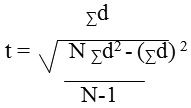
Where, d = the total of the difference
(∑d) = the total of differences squared
∑d = the total of differences squared differences.
N = Number of the objects
√ = the square root of the final calculation of everything under the Square Root sign.
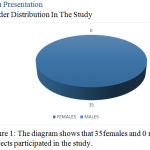 |
Figure 1: The diagram shows that 35females and 0 male subjects participated in the study.
|
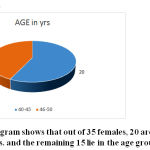 |
Figure 2: The diagram shows that out of 35 females, 20 are in the age group between 40-45 yrs. and the remaining 15 lie in the age group 46-60 yrs.
|
Data Analysis
Brief Pain Inventory
| Group | Pre training | Post training | t value | p value | Significance |
| 71.90±12.33 | 61.03±11.47 | 7.028 | <0.0001 | ES |
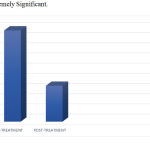 |
Figure 3
|
Interpretation
The above table and graph shows pre and post comparison within the group. Post training there was extremely significant improvement noted in both the groups according to the p values.
Brief Fatigue Inventory
| Group | Pre training | Post training | t value | p value | Significance |
| 53.83±11.03 | 41.78±13 | 9.57 | <0.0001 | ES |
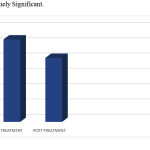 |
Figure 4
|
Interpretation
The above table and graph shows pre and post comparison within the group. Post training there was extremely significant improvement noted in both the groups according to the p values.
ES: Extremely Significant.
Cohen Perceived Stress Scale
| Group | Pretreatment | Posttreatment | T Value | P Value | Significance |
| 21.71±2.27 | 19.86±2.23 | 4.998 | <0.0007 | Es |
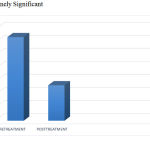 |
Figure 5
|
Interpretation: The above table and graph shows pre and post comparison within the group. Post training there was extremely significant improvement noted in both the groups according to the p values.
Rate of Perceived Exertion
| Group | Pretreatment | Posttreatment | T Value | P Value | Significance |
| 12.49±3.23 | 10.34±2.94 | 8.945 | <0.007 | Es |
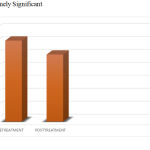 |
Figure 6
|
Interpretation
The above table and graph shows pre and post comparison within the group. Post training there was extremely significant improvement noted in both the groups according to the p value.
Discussion
This study “Effect of Physiotherapy on Fatigue and Psychological stress in cancer patients during the course of chemotherapy” was conducted to find out the effect of physiotherapy in cancer patients. A generic term for a large group of diseases, cancer is characterized by the growth of abnormal cells beyond their usual boundaries which then invades adjoining parts of the body and spread to other organs [1] Chemotherapy which is used to treat, cure, lessen and shrink the tumour stops or slows the growth of cancer cells. [2] Common side effects caused by chemotherapy include:
Fatigue, anaemia, nerve and muscle problems such as numbness, tingling, and pain.[2]
The objectives of this study were determine the effect of exercises to reduce fatigue during the course of chemotherapy. To determine the effect of relaxation techniques for reducing psychological stress in cancer patients during the course of chemotherapy. To determine the effect of pain reducing agents in cancer patients during the course of chemotherapy.
The study was conducted with 35 subjects. Prior consent was taken from them. The interventions were carried out for 5 days per week for 4 weeks. The outcome measures for this study were Brief Fatigue Inventory, Brief Pain Inventory, Cohen Perceived Stress Scale and Borg Scale.
The subjects received TENS for pain, Stretching, Warm up and Exercises and Relaxation along with 6minute walk and Harvard Step for decreasing fatigue and psychological stress. The exercises were prescribed based on FITTs principle.
This study showed that there was significant improvement in the outcome variables concluding that it decreases fatigue and stress.
This was confirmed using statistical analysis by using ‘Paired t- test’.
Brief Pain Inventory
Post training there was extremely significant improvement noted in reducing fatigue and psychological stress in cancer patients.
p value = <0.0001.
Brief Fatigue Inventory
Post training there was extremely significant improvement noted in reducing fatigue and psychological stress in cancer patients.
p value = <0.0001.
Cohen Perceived Stress Scale
Post training there was extremely significant improvement noted in reducing fatigue and psychological stress in cancer patients.
p value = <0.0007.
Rate of Perceived Exertion
Post training there was extremely significant improvement noted in reducing fatigue and psychological stress in cancer patients.
p value = <0.0007.
Post training improvement in fatigue and psychological stress is due to the fact that ]it produces gain in muscle mass and plasma volume, improved lung ventilation and perfusion, increased cardiac reserve, and a higher concentration of oxidative muscle enzymes thereby reducing fatigue and normalizing physical performance and release of happy hormones i.e. endorphins.[5] Improved physical performance can increase, independence and self-esteem of patients; which in turn can result in better social interaction and a reduction in anxiety and fear and secondary benefits like improved mood state.[5]
This suggests that physiotherapy is effective in reducing fatigue and psychological stress in cancer patients taking chemotherapy.
Conclusion
We found physiotherapy was significantly effective in decreasing fatigue and psychological stress in cancer patients receiving chemotherapy.
Conflict of Interest
There is no conflict of Interest.
Source of Funding
Krishna Institute of Medical Sciences Deemed to be University.
Ethical Clearance
Study approved by Institutional Ethics Committee of Krishna Institute of Medical Sciences Deemed to be University.
References
- Who.int/cancer/en
- Www. cancer.gov
- Smets E., Garssen B., Schuster-Uitterhoeve A., de Haes J. Fatigue in cancer patients. Br J Cancer. 1993;68:220–4.
CrossRef - Winningham M. L., Nail L. M., Burke M. B., Brophy L., Cimprich B., Jones L., et al. Fatigue and the cancer experience: the state of the knowledge. Oncol Nurs Forum. 1994;21:23–36.
- Dimeo M. D. C. F Effects of Exercise on Cancer-Related Fatigue. Cancer. 2001;92(6). version 5 of record online: 28 Sep.
- Greenleaf J. E., Kozlowsky S. Physiological consequences of reduced physical activity during bed rest. In: Terjung RL. Exercise Sport Science Reviews. 1982;10:84. Philadelphia: Franklin Institute Press.
- Germain P., Guell A., Marini J. F. Muscle strength during bedrest with and without muscle exercise as a countermeasure. Eur J Appl Physiol. 1995;71:342–8.
CrossRef - Levine B. D., Zuckerman J. H., Pawelczyk J. A. Cardiac atrophy after bed-rest deconditioning: a nonneural mechanism for orthostatic intolerance. Circulation. 1997;96:517–25.
CrossRef - Salmon G. P., Swank M. A. JEP online. Exercise-based disease management guidelines for individuals with cancer: potential applications in a high-risk mid-southern state. 2002.
- Loh J and Gulati A The use of transcutaneous electrical nerve stimulation (TENS) in a major cancer centre for the treatment of severe cancer-related pain and associated disability. 2017;10.







